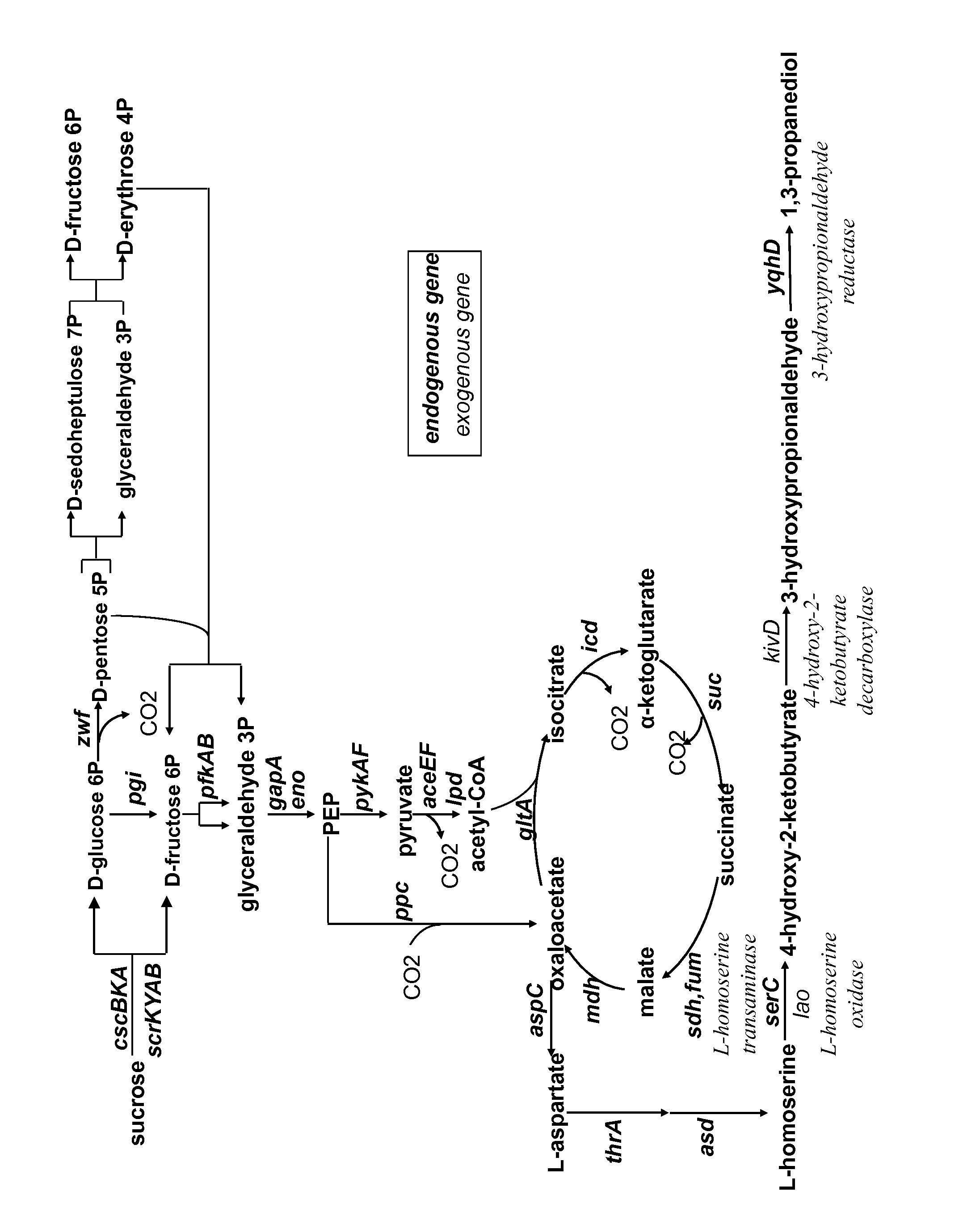Method for the preparation of 1,3-propanediol from sucrose
a technology of 1,3-propanediol and sucrose, which is applied in the direction of lyases, carbon-carbon lyases, transferases, etc., can solve the problems of high production cost and inability to economically sustain industrial production with refined sugars
- Summary
- Abstract
- Description
- Claims
- Application Information
AI Technical Summary
Benefits of technology
Problems solved by technology
Method used
Image
Examples
example 1
Calculation of Maximum Yields for 1,3-propanediol Production on Glucose and Sucrose
1.1—Parameters Used for Simulations
[0080]Simulations were performed with the METEX proprietary software METOPT™. A simplified metabolic network of E. coli was used including a central metabolic network, metabolic pathways for all biomass precursors and specific production pathways as described above. A classical biomass composition for E. coli was used. Simulations were performed using either glucose or sucrose carbon source. For sucrose utilization, both the PTS system and the non-PTS system were modelled. As there were no differences on maximal yields calculated, only one yield on sucrose is reported. Calculation of a practical maximum yield was performed, taking into account a growth rate of 0.1 h−1 and maintenance energy of 5 mmolATP·gDW−1·h−1. All simulations were performed with a specific uptake rate of glucose of 3 mmol·gDW−1·h−1. Simulations were performed under aerobic conditions.
1.2−Simulati...
example 2
Demonstration of the L-homoserine Transaminase Activity Encoded by the Gene serC of Escherichia coli
2.1—Construction of Strain for SerC Characterisation: BL21 (pPAL7-serC)
[0082]To characterise the SerC protein, the corresponding gene was expressed from the expression vector pPAL7 (Bio-rad).
[0083]For this purpose, the serC gene was amplified from the E. coli genome using the oligonucleotides pPAL7-serC F and pPAL7-serC R. The PCR product was restricted using enzymes HindIII and EcoRI and cloned into the vector pPAL7 restricted by the same restriction enzymes. The resulting vector was named pPAL7-serC.[0084]pPAL7-serC F (SEQ ID NO 1): cccAAGCTTtgATGGCTCAAATCTTCAATTTTAGTTCTGG
[0085]with[0086]a region (bold case) homologous to the sequence (956876-956904) of the gene serC (reference sequence on the website www.ecogene.org / ),[0087]a region (underlined case) harbouring the HindIII restriction site[0088]pPAL7-serC R (SEQ ID NO 2): gGAATTCTTAACCGTGACGGCGTTCGAACTCAACC
[0089]with[0090]a region...
example 3
Demonstration of the 4-hydroxy-2-ketobutyrate decarboxylase Activity Encoded by the Gene kivD of Lactococcus lactis
3.1—Construction of Strain for KivD Characterisation: BL21 (pPAL7-kivDll)
[0098]To characterise the KivD protein, the corresponding gene was expressed from the expression vector pPAL7 (Bio-rad).
[0099]For this purpose, the kivD gene was amplified from the Lactococcus lactis genome using the oligonucleotides pPAL7-kivDll F and pPAL7-kivDll R. The PCR product was restricted using enzymes HindIII and EcoRI and cloned into the vector pPAL7 restricted by the same restriction enzymes. The resulting vector was named pPAL7-kivDll.[0100]pPAL7-kivDll F (SEQ ID NO 3): cccAAGCTTtgACTTCTATGTATACCGTGGGTGATTATC[0101]with[0102]a region (italic case) homologous to the sequence of the synthetic gene of the Lactococcus lactis kivD gene,[0103]a region (bold case) harbouring the nucleotides necessary to generate tag-free protein containing a short N-terminal amino acid extension to favour th...
PUM
| Property | Measurement | Unit |
|---|---|---|
| temperatures | aaaaa | aaaaa |
| temperatures | aaaaa | aaaaa |
| temperatures | aaaaa | aaaaa |
Abstract
Description
Claims
Application Information
 Login to View More
Login to View More - R&D
- Intellectual Property
- Life Sciences
- Materials
- Tech Scout
- Unparalleled Data Quality
- Higher Quality Content
- 60% Fewer Hallucinations
Browse by: Latest US Patents, China's latest patents, Technical Efficacy Thesaurus, Application Domain, Technology Topic, Popular Technical Reports.
© 2025 PatSnap. All rights reserved.Legal|Privacy policy|Modern Slavery Act Transparency Statement|Sitemap|About US| Contact US: help@patsnap.com


